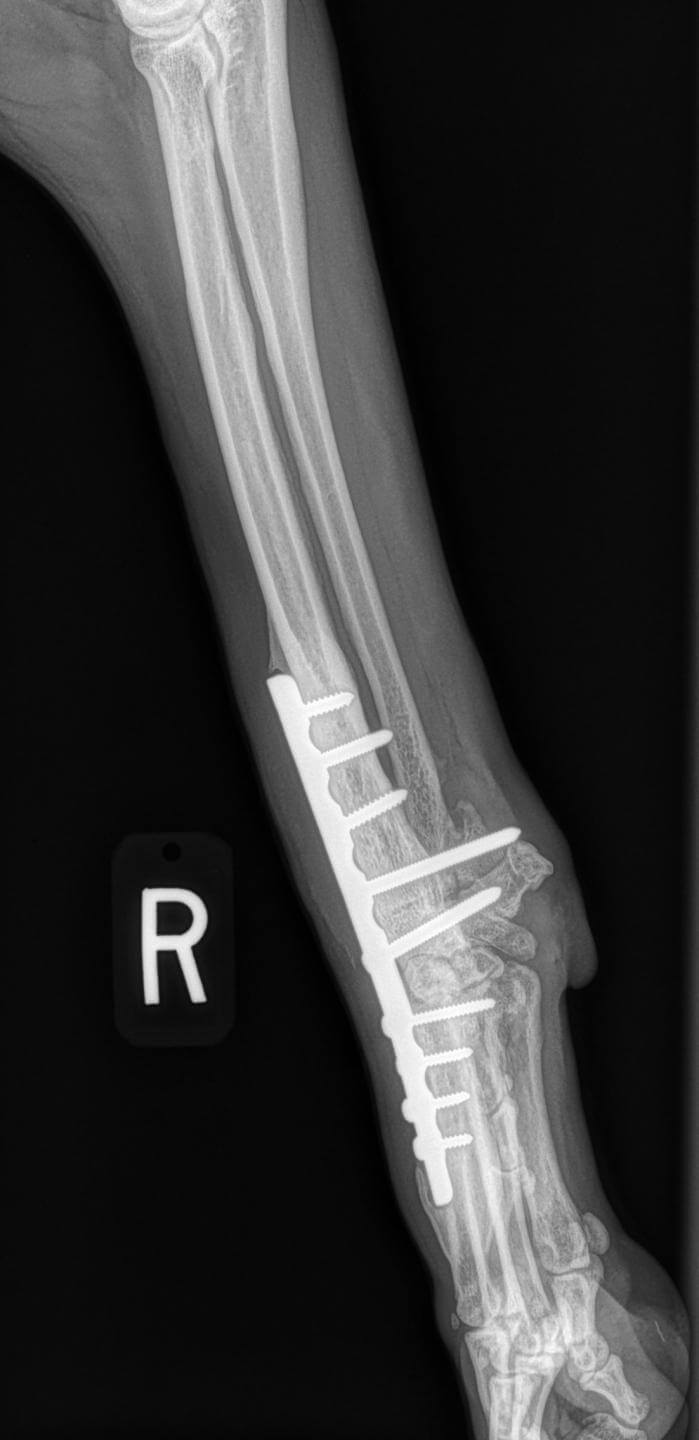Carpal hyperextension injuries are most commonly seen in large active dogs. However, small breeds can also be affected. Warning signs of this condition include lameness, swelling of the carpus, and sinking of the paw to the ground during exercise caused by excessive motion (hyperextension) of the carpus.
How can I tell if my dog has carpal hyperextension?
There are three common forms of injury to the carpus causing hyperextension:
1. The first form affects puppies and involves an abnormality in the development of the ligaments supporting the carpal joint. Affected puppies walk with excessive extension of the carpus (with a gait more like a bear than a dog). Both wrists tend to be affected in puppies with this condition and in some extreme cases, the hock joints (ankles) in the hind limbs can also be affected. Puppies that have ligament laxity and subsequent hyperextension of the carpus as a result of prolonged immobilization in a bandage are only affected on the bandaged leg.
extension of the carpus (with a gait more like a bear than a dog). Both wrists tend to be affected in puppies with this condition and in some extreme cases, the hock joints (ankles) in the hind limbs can also be affected. Puppies that have ligament laxity and subsequent hyperextension of the carpus as a result of prolonged immobilization in a bandage are only affected on the bandaged leg.
2. The second form of injury to the carpus is the result of trauma. There are varying degrees of sprain injury affecting the carpus. The amount of lameness and swelling depends on the severity of the trauma. Some dogs will have an obvious postural abnormality with an inappropriate deviation of the affected joint.
3. The third form of carpal injury is degenerative hyperextension of the wrists. This problem affects older dogs and is especially common in Collie breeds. There is a tendency for one or both carpi to gradually sink until they completely collapse.
Some problems affecting the wrist joint also affect other joints and are in the group of polyarthritides. These are the animal equivalent of rheumatoid arthritis and can affect the joints of the fore and hind limbs of dogs and cats.
How is carpal hyperextension diagnosed?
Carpal hyperextension is typically diagnosed following a multimodal evaluation process. Firstly your dog will be examined to ascertain the nature of the disease. Following this, your dog will most likely be admitted to the hospital to allow radiographs of the affected joints under sedation or general anesthesia. With this particular disease, we perform a series of specific radiographs called ‘stressed views’. This entails taking a radiograph of your dog’s carpus in the position that truly reflects the extent of the hyperextension i.e. mimicking a fully weight-bearing position. This helps the orthopedic clinician assess which ligamentous structures are damaged and facilitate the overall decision-making process as to what treatment is best for your dog.
Your dog will receive one-to-one care throughout the imaging process by one of our registered technicians, who are all highly trained and experienced in anesthesia and sedation. Following clinical examination and diagnostic imaging, we will be able to advise on the most appropriate course of treatment for your dog, be it conservative (non-surgical) management or surgical management.
A physical examination can give us a good idea of the nature of the problem. We may perform special stressed radiographic tests to help us assess which ligamentous structures are damaged. In animals where broken bones are suspected but are not seen on the plain radiographs, we may refer your pet for CT or MRI examination.
What are the usual treatment options?
The most appropriate treatment for carpal hyperextension depends on the underlying cause. Conservative management including supportive splints or bandages and physiotherapy can be an option for some animals with developmental hyperextension or animals with low-grade sprain injuries. Recently, customized carpal supports have been developed that may allow daily use and may be easily put on and taken off without causing pressure sores due to prolonged application. 
Should your dog’s hyperextension injury be the result of a fracture, surgery will be required to stabilize the fracture and in turn provide overall joint support. Depending on the extent of your dog’s injuries, the carpus may also require complete or partial fusion.
Severe, high-grade sprain injuries and most forms of degenerative hyperextension are usually treated by fusion of the carpal joint. This procedure is called pancarpal arthrodesis. Pancarpal arthrodesis involves the fusion of the forelimb (antebrachium) with the paw across the carpal joint using a combination of plates and screws. We have led the field in the development of new technologies of internal and external skeletal fixation in this arena.
If a diagnosis of immune-mediated polyarthritis is made, the treatment is usually medical. Rarely, some dogs and cats require fusion of their carpal joints if they are affected by severe polyarthritis.
